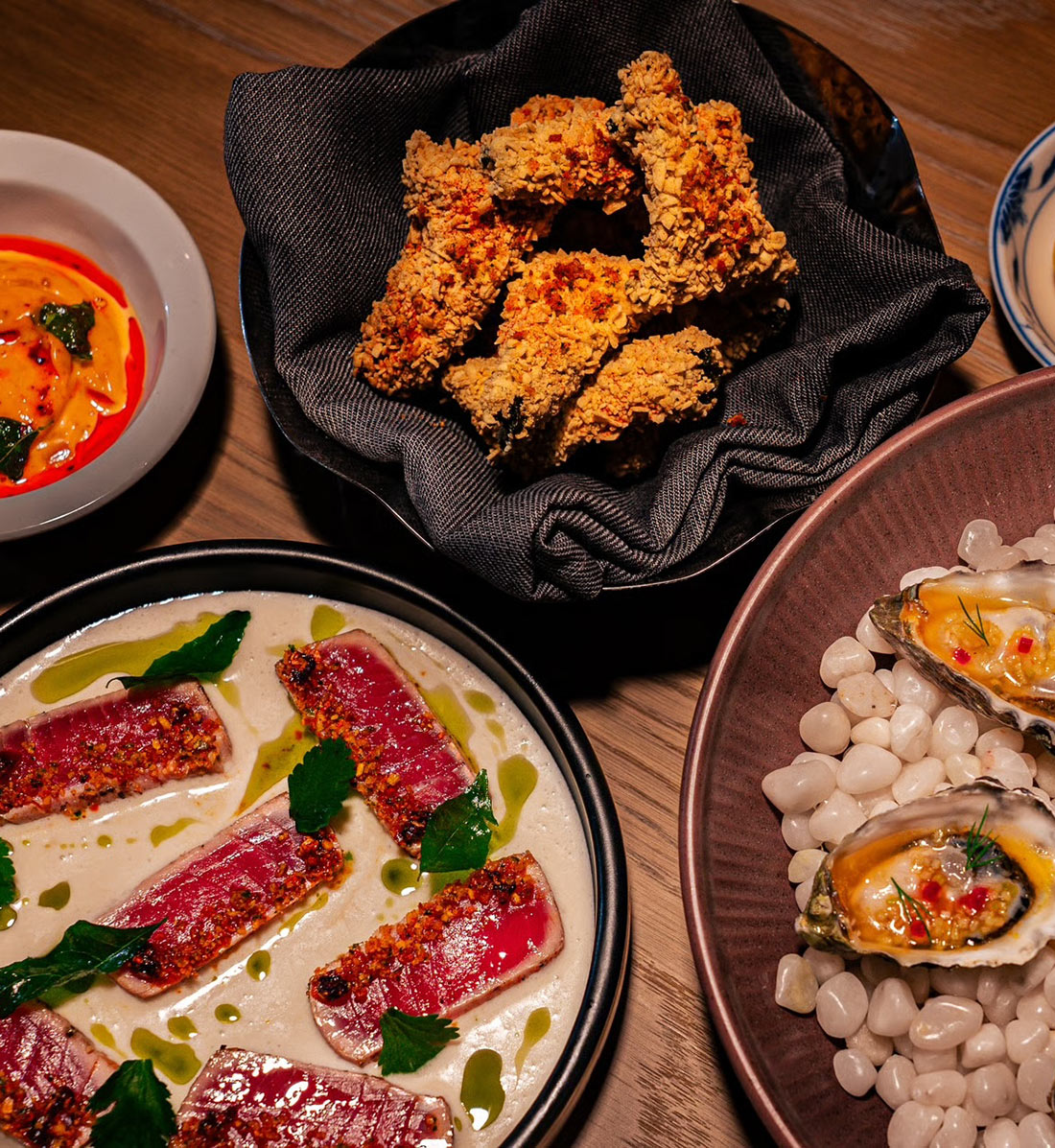Serving oysters at home may seem intimidating — after all, they are live bivalves that require cleaning, shucking, and proper chilling. Don’t let this deter you, though, as once you have the techniques down, it’s one of the simplest ways to impress guests, whether at a backyard barbeque or colder weather holiday gathering.
Master the art of serving oysters at home with these tips from MICHELIN Guide chefs.
Tips for choosing
“Buy the ones that are raised closest to you,” advises Chef Jody Williams and Chef Rita Sodi of Via Carota.
“Ask to see the shellfish tags that retailers are obligated to have here in the States,” says Michael Cimarusti, chef at Two MICHELIN Star and Green Star Providence. “You will want to buy oysters that are no more than five days out of the water.”
If you’re planning on grilling oysters, “look for oysters that feel heavy for their size, which means they have juicy meat perfect for grilling,” says Daniel Huynh, chef at Vietnam's Regent Phu Quoc. “Give the shells a light tap—fresh oysters will sound solid and have tight shells. Stay away from oysters with open or hollow shells.”
Tips for cleaning and preparing
“Buy more than you need,” cautions Williams. “If say, you want to eat a dozen oysters, buy two dozen, and forgive yourself if you get crumbled shell on some of them or spill the oyster liquor—soon you'll get the hang of it.”’
Sodi adds, “Scrub them under running cold water with a stiff-bristled brush since a lot of sand and dirt can get trapped in the hinge at the back of each shell.”
Tips for opening
“Shucking oysters should not be approached as a feat of strength,” says Cimarusti. “Opening an oyster is about finesse and gentle pressure applied in the right spot.” Once you pop the oyster open, gently slide the knife under the flesh of the oyster to cut the abductor muscle so that the oyster will fall out of the shell when you tip it into your mouth.
“To protect your hands, use a special metal glove or protect your hands by wrapping the oyster in a towel while opening them,” says Gert De Mangeleer, chef at Two MICHELIN Star Hertog Jan at Botanic. “You should also invest in a good (read: more expensive) oyster knife; the cheaper ones can break while opening the oysters. Make sure to always collect the oyster juice over a bowl, it’s a real taste maker in different preparations.”
“Inspect the oyster to ensure there are no shell fragments,” says Tyler Kineman, chef de cuisine at Knife & Spoon. “Flip the oyster in the shell for a cleaner presentation.”
“Keep oysters on ice while you open the rest,” advise Williams and Sodi.


“When serving oysters on the half-shell, be sure to pick a plate or a platter that is deep enough to hold a good bit of crushed ice,” says Cimarusti. “Pack the plate with ice, be sure it is level and place each oyster in the ice so that the deepest part of the shell is nestled into the ice. Also be sure that the cup of the oyster is level and resting on the edge of the plate to not lose the precious liquor, which is the essence of any great oyster.”
Kevin Gillespie, chef-owner of Gunshow, loves to grill oysters, but he warns: not all oysters are good for grilling. “This is where Gulf oysters really shine. You want big, meaty oysters that do not have too much salinity. You want them to be more 'mineral-y' less brine,” he says, adding that the trick is to grill them really hot and really fast. “A little flare up is good since you're charring the shell, not the oyster. That will add a smoky flavor. I like to put spiced butter on my oysters before I grill them, then you don't need another sauce."
You can also try grilling oysters with the lid down over indirect heat for an oven-like effect, suggests Huynh. “Just be careful not to let the shells get too hot and start popping,” he advises. “If your grill grates aren't level, use a tray to level them and prevent the oysters from falling over.” Lastly, and most importantly, he says placement is key to a perfectly grilled oyster: the rounded side needs to face down to help the oysters cook evenly and stay in place.
“Oyster tempura offers a way to elevate your oyster game with a delicious tempura preparation,” says Bas van Kranen, chef at Two MICHELIN Star and Green Star Flore. “This is ideal for serving as a snack or incorporating into a salad.” He likes to prepare a classic tempura batter and enhance it with the addition of raw hemp seeds for extra texture. “To coat the oysters, first dip them in flour, then in the tempura batter, and finally in the hemp seeds and fry them for about two minutes at 190C / 375F for the perfect crunchy coating.”
Tips for presentation
“Ensure you have a big ol' serving tray filled with crushed ice ready,” says Huynh. “Raw oysters are best served on a metal tray because it keeps them nice and cold.”
To manage the meltwater and keep your presentation neat, Sean Runyon, chef de cuisine of Shutters on The Beach says to place a thin napkin or cloth under the ice. “For best results, use properly crushed ice; if you don’t have pre-crushed ice, you can make your own by placing ice cubes in a bag and gently breaking them with a mallet or pan. This method ensures the oysters stay chilled and appealing throughout the meal."
“I always like to serve oysters with granita. It adds great flavor and keeps the oysters ice cold as the granita melts,” says Jeff Armstrong, executive chef at Paradisaea.
“Adding some salt to the ice will help the ice stick together and prevent your oysters from sliding around,” says Kineman. “Most Asian markets will have dried seaweed that you can rehydrate in water and arrange on top of the ice for a nice color pop for your presentation.”
For a classic touch, serve your oysters with lemon wedges for a burst of fresh citrus. “It'll help balance out the salty taste of the oysters,” explains Huynh. “If you're feeling fancy, you can add some fresh herbs, ginger, chili flakes, or lime juice. Plop those oysters on the ice with the narrow end facing inward, and you're good to go.”

Mignonette Recipes:
Cucumber Mignonette
Courtesy of Chef Jody Williams and Chef Rita Sodi, Via Carota
½ a seedless cucumber, such as English (4 inches/10 cm)
½ small shallot, very finely chopped
1 lemon, zested and juiced
2 fresh basil leaves
Salt
Directions: Peel the cucumber, leaving a few strips of skin on for color. Grate it into a bowl on the medium holes of a grater and season with a pinch of salt. Rinse the shallots in a fine-mesh strainer with cold water and drain. Stir the shallots into the cucumber. Zest the lemon directly into the bowl and squeeze in the juice (for about 1 teaspoon zest and 3 tablespoons/45 ml of juice); stir to combine. Stack the basil leaves on top of each other in an orderly way. Roll them up and draw your knife across them to make fine shreds. Finely chop the ribbons and stir into the mignonette. Makes about 1 cup, enough for 1 dozen oysters.
Splash of Gin
Courtesy of Carlos Garcia, executive chef, LEKU
110g (3.8 oz) shallots
60g (2 oz) red wine vinegar
30g (1 oz) Nordes gin
17g (0.5 oz) fresh lime juice
1 pinch black pepper
Directions: Cut the shallot very small, and leave it in the ice water to reduce the strong flavor of the onion. Let the entire sauce rest in the refrigerator so that the flavors mix.
Splash of Lillet
Courtesy of Rose Noel, executive chef, Peak
400g (14 oz) white wine vinegar
20g (0.7 oz) black peppercorn, freshly cracked
Lillet to taste
200g (7 oz) shallots, brunoised
Directions: Mix all ingredients together and let it sit in the fridge for a few hours to mix.

Hero image: James Tran / Paradisaea





















